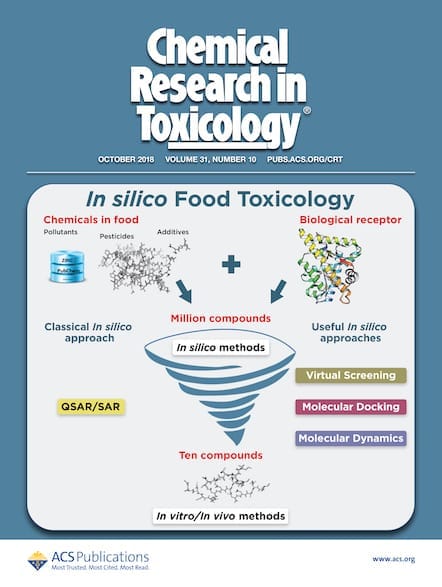Jonathan W. Steed, Professor of Inorganic Chemistry at Durham University in the United Kingdom, will serve as the new Editor-in-Chief of Crystal Growth & Design beginning January 2020. He is preceded by Robin Rogers, who has led the journal as its founding Editor for 20 years. “It is a great honor to take on the […]

Jonathan W. Steed, Professor of Inorganic Chemistry at Durham University in the United Kingdom, will serve as the new Editor-in-Chief of Crystal Growth & Design beginning January 2020. He is preceded by Robin Rogers, who has led the journal as its founding Editor for 20 years.
“It is a great honor to take on the leadership of Crystal Growth & Design. It’s a journal whose quality mirrors the beauty of the crystals we all love in our research. I am looking forward to building on the journal’s outstanding reputation and broadening its scope to encompass the ever-increasing diversity of solid-state materials and the researchers who study them,” Steed said.
Steed is known for his work on crystalline molecular solids, and crystal growth methods, particularly using supramolecular gels. He has a broad perspective on molecular solids, as exemplified by his highly regarded book Supramolecular Chemistry, first published in 2000. Steed’s research has led to significant international recognition throughout his career. He is the recipient of the 1998 Royal Society of Chemistry (RSC) Meldola Medal, the 2008 Bob Hay Lectureship, the 2010 RSC Corday-Morgan Prize, and a 2018 Royal Society Wolfson Research Merit Award.
Read An Exclusive Interview With New Crystal Growth & Design Editor-in-Chief Jonathan W. Steed:
What are your goals as Editor-in-Chief?
The journal leads the field in the creation, understanding, and application of crystalline materials. I am passionate about adopting an inclusive approach to both chemistry and the researchers who study it. I’d like to see the journal’s reputation of fusing disparate ideas expand to encompass soft materials – things like gels, nanoscale assemblies, and liquid crystals. I also want to make sure that we are truly representative of the researchers who read the journal and foster new and diverse talent in the next generation of scientists. As an author myself, I am particularly keen to make sure that our contributors and referees receive prompt and fair treatment. We cannot publish everything, of course, and that means making some hard decisions, but these must always be based firmly on the science and articulated clearly to our authors.
What do you see as the biggest challenges and opportunities in the field today?
It’s a halcyon time to be working on crystalline materials. There have been game-changing developments in structure determination, such as the rise of micro electron diffraction techniques and the use of crystalline molecular flasks. These experimental developments go hand-in-hand with the increased efficacy and accessibility of crystal structure calculation methodologies. The synergy between experiment and calculation is driving forward design and markedly expanding the range of materials we have access to, particularly among porous crystals. The field is also highly industrially relevant and the stimulus from the pharmaceutical industry, in particular, is bringing the latest in cutting edge methodology to bear. The ecosystem is also enriched by creative developments in crystal growth, for example, at high pressure, in magnetic fields, or in nanoconfined space. The challenges to the field are external – nothing to do with the science. They stem from political decisions that impact on the mobility of researchers, public confidence in scientific objectivity and funding, particularly for early career researchers, and under-represented groups.
Why should people outside the field take an interest in Crystal Growth & Design? How does it affect people’s lives?
We all need medicines. Almost no oral pharmaceutical would be available without careful control of the solid-state form of the drug. It is the properties of the crystal that determine how the medicine gets into the body in order to have a therapeutic effect. The shaping and understanding of crystalline materials underpin a great deal of modern life – semiconductors, foods, agrochemicals, batteries, energetic materials all depend on an understanding of solid-state properties for their function. When we think of a crystal, we always imagine a gorgeous gemstone, and there’s nothing wrong with that image – in fact, it’s a very powerful outreach tool. But the ‘healing powers’ of crystals come from powders of pharmaceuticals rather than the facets of an emerald.
How do you see the journal and the community working together to address those challenges and seize those opportunities?
Where do you want Crystal Growth & Design to expand?
Crystallization is just one outcome of the assembly of ions or molecules under a supersaturation gradient. This kind of process is linked to the formation of a wide variety of interesting materials such as gels, liquid crystals, and coamorphous materials. I think Crystal Growth & Design is the ideal forum for research that cuts across these boundaries, and I’d like to see the journal showcase research in the assembly of soft and composite materials alongside its traditional strength in molecular crystals, MOFs, and novel crystal growth methods. Perhaps more importantly than the science, however, I would like to see the journal grow globally, reaching out to early career and underrepresented researchers across the globe with new ideas. I’d like to ensure that the journal continues to grow its reputation for fairness, transparency, and objectivity.
Crystal Growth & Design is focused on theoretical and experimental studies of the physical, chemical, and biological phenomena and processes related to the design, growth, and application of crystalline materials.
